One of the first considerations would be if the deck can withstand the climate of the Pacific Northwest. It’s important to choose the right decking material as well as a design and layout plan.
Decking Material
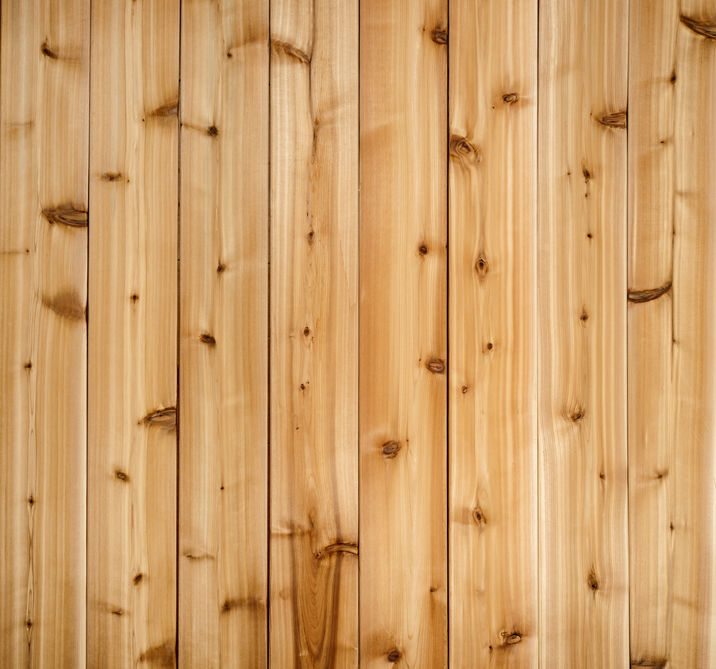
Hardwoods
One of the determining factors is the type of decking material to be used. If you choose a natural/sustainable material, it should be able to withstand the elements, pest control, and the resistance to rot. Western Red Cedar (Clear and Tight-Knot) and Redwood are two favorites however they still need a waterproof sealer.
Exotic hardwoods are Brazilian Ipe (pronounced “ee-pay”) and Massarunduba aka “Bulletwood” which is also used for shipbuilding, furniture, etc. Another is Tigerwood known as Brazilian koa, and Congowood, which is an evergreen with different species.
It’s a beautiful wood with a Janka hardness of 2160 which means it’s resistant to rot and decay. KAYU® – Batu™ is a darker reddish-brown hardwood which is low maintenance and you can let it naturally weather to a silver patina color or clean, wash & oil to bring back the decks natural beauty and warmth. All of these hardwoods are resistant to rot and naturally repel pests.
Juniper is another choice as it’s locally grown in Oregon. The decking material should be able to withstand the harsh environment.
Kebony wood is a modified “softwood” developed in Norway. The Kebony® technology enhances the properties of sustainable softwood with a bio-based liquid, a process which permanently modifies the wood cell walls giving Kebony premium hardwood characteristics and a rich brown color.
After exposure to sun and rain the wood develops a natural silver-gray patina. It’s available in clear and character grade. You want to make sure all your product is certified by the FSC (Forest Stewardship Council).
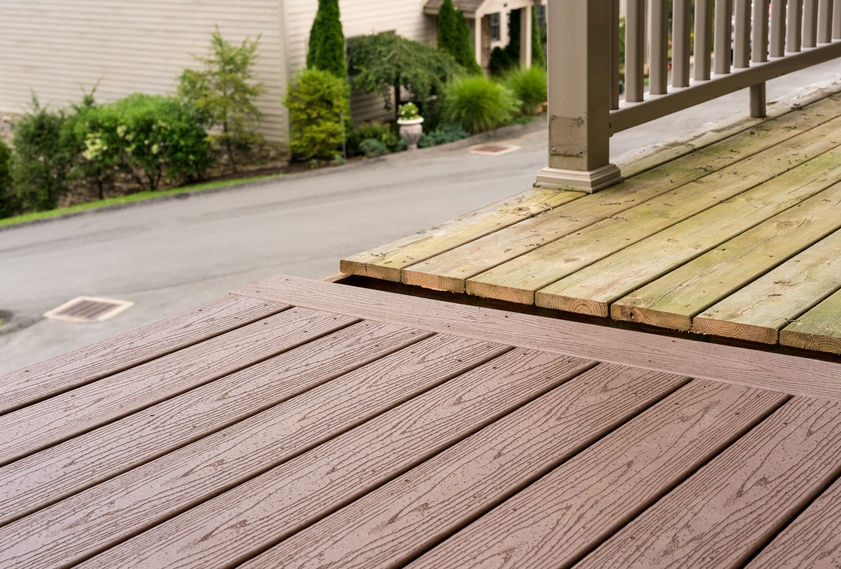
Composite Wood Decking
Composite wood decking is a combination of plastic and wood fibers which makes it a great option however it’s important to note that water leaks into a less dense wood-plastic composite, it can cause mold, mildew, and in some cases, decay- irreversible damage that will require replacing the deck to fix.
There are several to choose from:
WPC decking is one of the most popular choices because the material is made of lightweight honeycomb construction and are reversible with narrow spaced grooves on one side and wider spaced grooves on the other. Both sides provide a robust anti-slip walking surface, are easy to clean, and require very little maintenance.
BamDeck® is made from 100% recycled materials: 60% recycled bamboo fibers and 40% recycled HDPE plastic. Bamboo is known for its exceptional durability, and the bamboo fibers in BamDeck® give it industry-leading strength and density, making it inherently stronger than other wood-based composites or plastic decks, available in matte and wood grain.
BamDeck® 3G Wide Plank Composite Decking is redefining the look of composite decking, each wide deck flooring board is 50% wider opening up a range of new design possibilities that installs 30% faster.
TruOrganics® Composite Decking, a next generation composition and 3G core ensure higher tensile strength and resiliency, while a full protective wrap shield guards against stains, scratches, snow, and sun damage. Wide planks and a hidden fastening system mean simple, clean installations — perfect for the DIY homeowner.
TruOrganics® is made of recycled materials (60% recycled wood fibers, and 40% high density plastics) and a Hidden Fastener System: Groove and Groove.
Aboeda’s ZomTek composite wood decking is made of bamboo fibers, recycled polyethylene plastic and a choice of colors (coffee, copper, slate, teak, and chestnut). There are three kinds which are solid planks; “iBeam” planks (they have four hollow chambers) which reduces weight; and 12-by-12-inch interlocking tiles placed on plastic grids.
Accoya® which is created from Pine. Their production process begins with the free hydroxyl groups within the wood is changed into acetyl groups which reduces the ability of the wood’s cell walls to absorb water by approximately 80%.
Moso is for both residential and commercial projects in the Pacific Northwest. Because of its strength and resistance to rain, snow, ice and sun, Moso is well suited for decks against all the elements.
Fiberon Symmetry Decking features PermaTech®cap layer which resists fading and staining, while the durable composite core means no splintering, cracking, insect infestation, or decay. It comes with the signature railing. The Fiberon Horizon Decking is capped (or covered) on all four sides with PermaTech® surface material and never needs sanding, staining, or sealing.
Trex Transcend Composite Deck offers many colors and railings to choose from. The surface is high performance, weather resistant, and the core is 95% recycled products from reclaimed wood and recycled plastics.
PVC (polyvinyl chloride) Decking
Azek/TimberTech provides a wide range of products to choose from: Vintage, Arbor, and Harvest Collections. It is 100% recycled plastic. For an eco-friendly wood alternative, Paramount PVC Decking is slip resistant whether wet or dry, and is approved for use in all Wildland Urban Interface (WUI) zones. Gossen PVC Tongue & Groove decking boards are another popular decking brand.
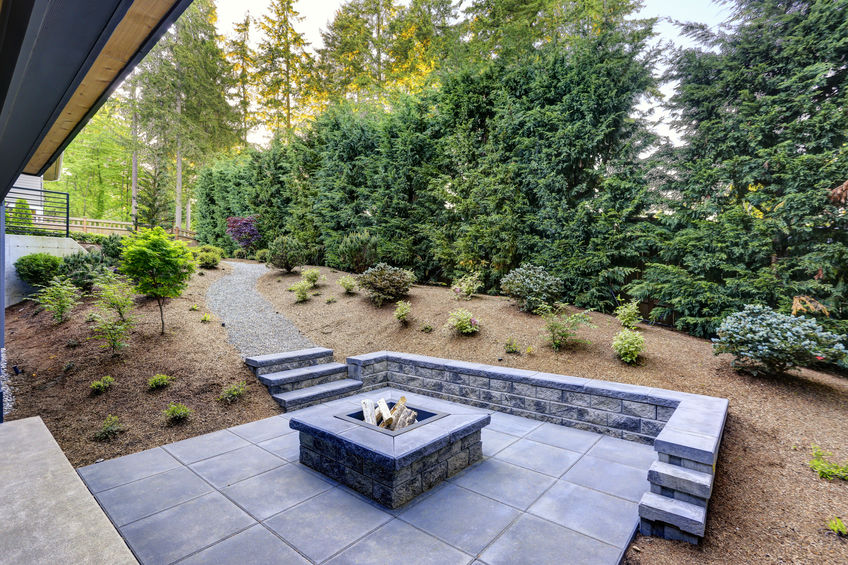
Stone and Precast Concrete Decking
Stone decking is a new durable, plastic polymer grid system is facilitating the installation of stone up to 3-inches thick on elevated surfaces. The Silca System is designed to support the structural load across a 16-inch on-center span, opening the entire range of stone options for elevated surfaces to include the use of natural stone pavers, travertine, pavers, slate, marble and tile.
StoneDeks System is different. Their SilcaGrate™ is a structural support underlayment that enables you to put any type of stone, paver, or brick on a wood or metal frame structure. It can be used to put stone, porcelain, travertine or pavers on decks.
Lastly, Dekstones are made from a mixture of 4,000 psi concrete and color, then reinforced with a specially designed welded wire mesh. They are custom-poured, which provides a handcrafted look, and due to their natural ingredients, slight variations in color help make each deck unique.
They are available in four distinct colors (Wheat, Agave, Sterling Gray, and Tuscan Amber). Traditionally porcelain has been used for extensive indoor applications but now with our advanced manufacturing technology, porcelain slabs can be used for a wide variety of outdoor hardscape applications.
From Abbotsford Concrete, The Aristokrat® Series is perfect for terraces, roof decks, patios, courtyards, swimming pools, water features or any traditional hardscape areas. Porcelain slabs deliver performance, style, versatility and are resistant to staining, fading, marking, chemicals and extreme weather.
All slabs come with our proven ‘Anti-Slip’ surface and are available in over 20 rich color blends with subtle variations and textures that emulate natural Limestone, Granite, Travertine, Marble and Quartz. They are low maintenance, durable and stain resistant.
Another product is the StoneHenge Series consisting of three tumbled blocks in four beautiful color bends that can be used in an infinite variety of ways to build your dream outdoor living space i.e. Open-Air Kitchens, Pizza Ovens & Grills, Fire Pits & Fire Tables, Refreshment Bars, Pub style & Kitchen Tables, Water Features, Bench Seats- linear or curved, Fireplaces,
Privacy walls and Fences, Pergolas & Pavilions, the list is endless. StoneHenge Units install quickly and easily simply adhering to each other using a premium grade concrete construction adhesive. They literally look like bricks.
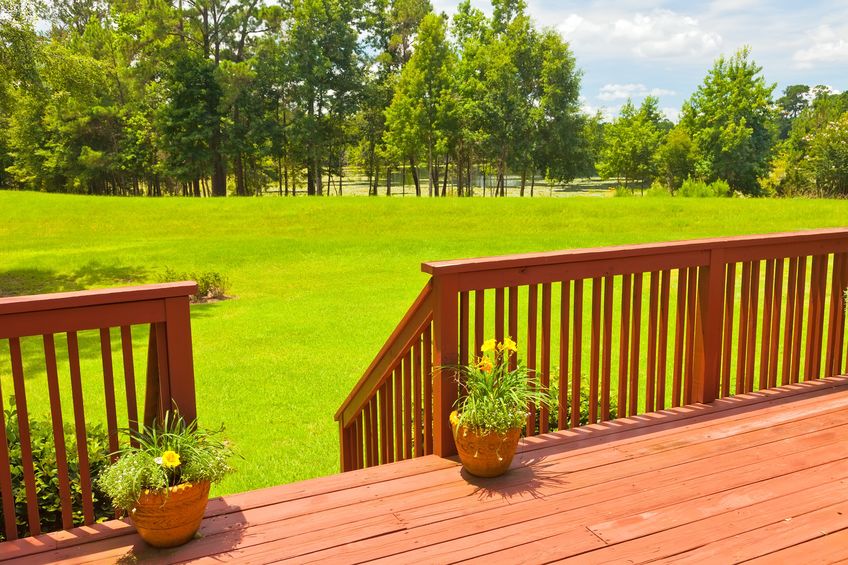
Deck Substructure – Girters (Beams), Guard Rails and Framing
Any project should begin with a pressure treated support system with concrete footings and flashing at the flanging frame plate, using the highest quality screw down fasteners for long term protection, and expertly executing siding-to-wall intersections. The posts, beams and joists are the Deck Substructure.
Deck girders provide the backbone of support for the joists, deck boards, post and railings that make up the middle and upper structure of the deck. Deck framing is incredibly important as it determines the structural integrity and strength of your outdoor living area. The posts should be spaced no more than 8 feet apart.
Some builders position them every 4 feet for a completely rigid frame. The maximum distance between footings is determined by the size of your joist material. 2×12 skirt boards should be used.
The size of footings supporting piers and columns shall be based on the tributary load and allowable soil pressure. The guardrail should be able to resist a 200-pound load which if applied at the top of the guardrail, creates a large leverage force where the guardrail attaches to the deck framing.
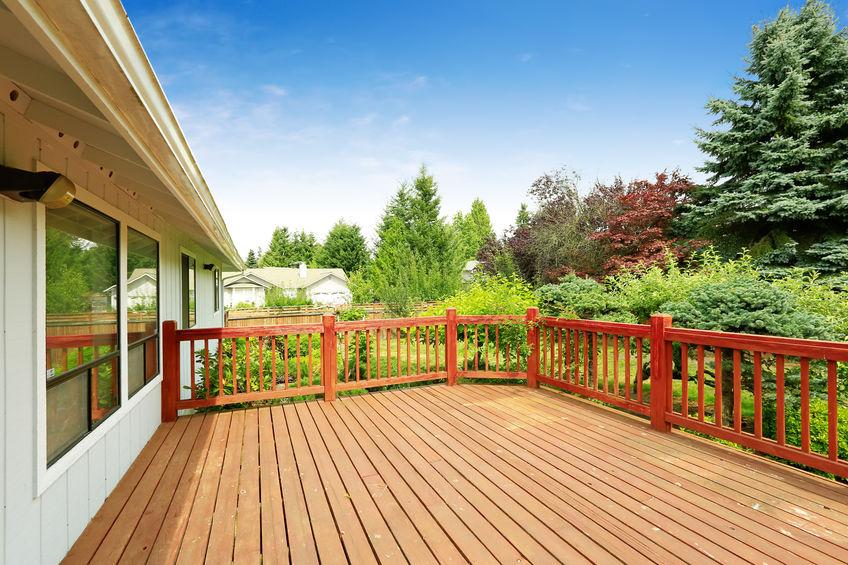
Deck Fasteners and Stair Stringers
Tiger Claw hidden deck fasteners hold-down power for woods, synthetic and composite decking materials. They allow the beauty of the deck to be preserved and reduce splitting, splintering, cupping and rotting.
The DJT14Z attaches 2x deck joists and beams to the side of 4x or larger support posts. LUS Joist Hanger provides bearing and uplift resistance and features double shear nailing for added strength.
H1 Hurricane Tie holds joist on both sides. DTT Deck Tension Tie is a horizontal application fastening railing post to deck framing. One of the most common causes for deck failure is ledgers that pull away from the primary structure, resulting in complete collapse.
Stair stringers must be properly connected to the deck, and treads properly connected to the stringers, in order to resist loads. In addition, code requirements regarding openings between stair treads and stair railing must also be met.
Simpson Strong-Tie® ZMAX® coated (G185) and hot-dip galvanized (HDG) connectors and fasteners may provide adequate corrosion resistance.
Quik Drive auto-feed screw driving systems are ideal for fastening decking because they combine the efficiency of stand-up driving with the holding power of screws, providing the best long-term results.
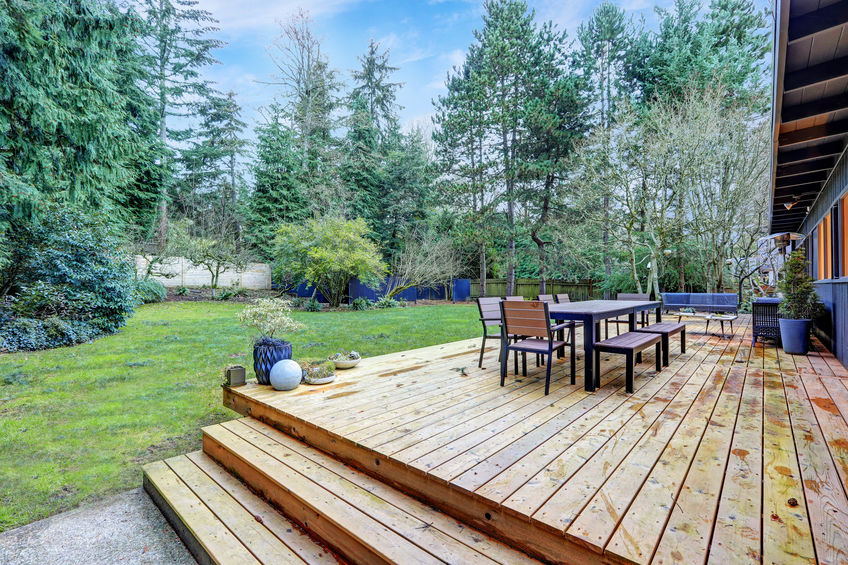
Steps or Stairway, Skirting, Fascia, Borders, Balusters, Railing and Framing
In order to build stairs for a deck, you must find the total rise or overall vertical height the stairs have to cover. Deck stairs are typically made from 2 x 12 stringers spaced about 12 to 16 inches apart.
They rest on a solid foundation and are attached to the deck with hangers. They have risers (also called toe kicks), treads and railings. The stairs should be at least 36 inches wide.
Deck steps and stairways should be carefully planned so that all the stair rises (the vertical height of the steps) and all the tread depths (the horizontal length of the step runs) are equal.
Deck skirting is a material connected to support post and also boards listed below a deck. Fascia is installed under the decking. Spiraling, Curved, and Winder/Turned Staircases with landings need to be planned out.
Balusters can enrich your deck railing and provide vertical support. The balustrade consists of several balusters spaced evenly and connected together to form a decorative railing supported by baluster posts.
You can choose from a large array of colors and finishes such as aluminum, composite, glass, brushed aluminum, or wood as well as highlight your railing with accessories/border styles i.e. TREX Border Zipper and RaceTrack and TRANSCEND® RAILING in Classic White and Vintage Lantern are durable.
Invisirail tempered glass deck railing is a favorite with a choice of the InvisiPosts, VistiPosts, TREX Reveal, square Aluminum, Cable Railing, Veranda Deck Railing, and metal Hand Rails. A classic herringbone pattern using Weathered Brickstone Charcoal Blend makes a stunning design when accented by the cobblestone.
Coating for Decks, Flashing
Along with waterproof sealers for hardwoods, there are acrylic resin coatings used for composite decking to give it a glossy/shiny coat. Examples are DuraTec, DuraDeck, and Westcoat ALX.
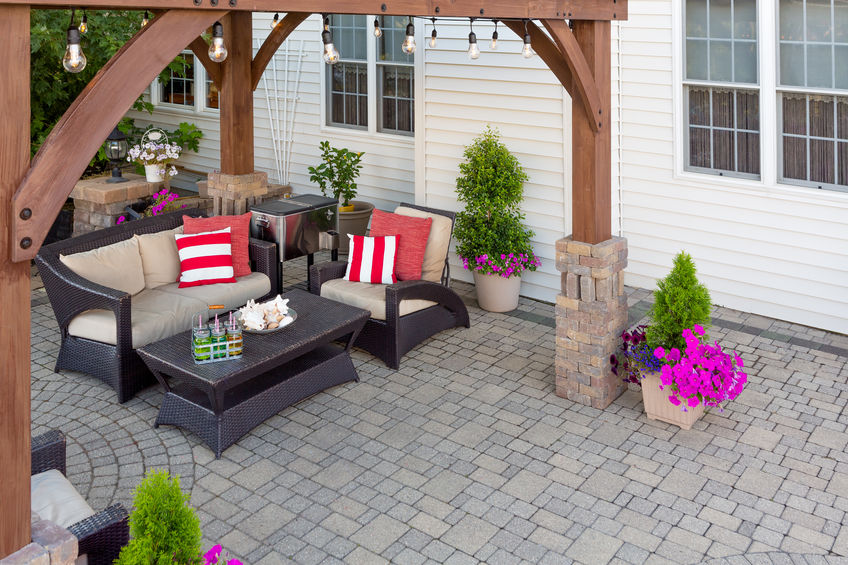
Design and Plan
Every design starts with an idea. That idea sparks and propels us to try new things. Multi-tiered decks and continuous stairs are very popular which gives you possibilities of how to utilize the space.
One idea might be that you can highlight a covered gazebo – an in-ground jacuzzi with low lighting for night then another nearby area secluded to entertain/bbq/fully-equipped outdoor oven and kitchen with wraparound bench seating for eating/drinking.
With Privacy walls to soundproof and Crutchfield outdoor Bluetooth Speakers, everyone gets to share their playlist or you could build a small stage to perform for friends and family. This is a continuation of stepping down to a garden/veranda/patio or pergola area with lounge chairs/umbrella or exterior showers.
Also, there may be multi-levels that have stairs leading up to a balcony deck or roof overlooking an infinity pool and this gives another design element to play with. You can have half-moon shapes for the railing and that provides a backdrop.
Conceptualizing the Design first is key before you can set out a plan. Whether this is a remodeling project with an existing deck or you want to begin with a fresh slate,, there are a million questions that lay ahead of you and you need someone you can trust with everything.
Deck Safety
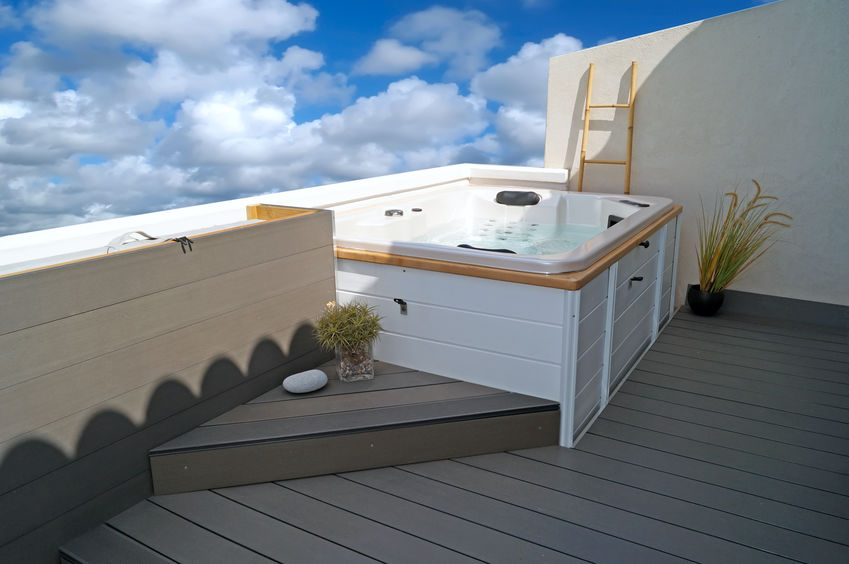
How much weight can my deck hold?
When you plan a deck, if you have any inclination to add a hot tub, this is what you need to know. Hot tubs must be placed on a flat, level surface, such as a concrete slab or a deck, without any shims.
Beyond that, many structural and design decisions depend on the particular hot tub chosen, so clients need to select their tub early in the process. Only when you know the tub’s dimensions, dry weight, water capacity, and suggested occupancy can you figure out how much weight the slab or framing will need to support.
For instance, an 8,000 pound hot tub could increase the required load capacity of your deck up to 100 psf.
The load that is placed on your deck is expressed in pounds per square foot (psf) and the total load or more appropriately, the design load is comprised of the dead load and the live load.
The dead load is basically the load created by the weight of the deck itself. This is usually about 10 psf. The Live load is created by all the extras i.e furniture, planters, and people. This is usually about 40 psf. Together the design load would be 50 psf.
In order to be able to determine the amount of force that is exerted from the deck surface to the footings, it helps to conceptualize the path that the forces travel from their source to the ground.
According to Don Bender, the director of the Composite Materials and Engineering Center at Washington State University, the deck is the most dangerous part of the house. Washington State Magazine’s article Making Decks Safer reports “Decks cause more injuries and loss of life than any other part of the home structure.
Except for hurricanes and tornadoes, more injuries may be connected to deck failures than all other wood building components and loading cases combined.” The life expectancy of a deck is about 15 years.
Adding a wooden deck allows homeowners to recoup 101.2% of the value they put into the deck. For composite deck additions, the ROI is slightly less, but still impressive at 80%. This means you can expect your home’s value to increase by more than the amount of the cost of a new wooden deck. That’s smart money.
Trust Denis Vladyko and the Corvus Team, for all your residential remodeling needs whether it’s Remodeling or Building Services, commitment and trust are our cornerstone. Corvus Construction Call us at 206-364-8089
to set up a free consultation.
